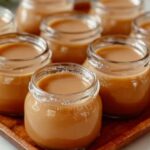Description
This Pear Honey recipe transforms ripe pears into a luscious, naturally sweet syrup infused with honey and a hint of lemon. Perfect as a topping for desserts, pancakes, or yogurt, this homemade honey alternative captures the warm flavors of fresh fruit and gentle simmering, offering a delightful and healthier sweetener option.
Ingredients
Scale
Ingredients
- 4 ripe pears, peeled, cored, and chopped
- 1/2 cup honey
- 1/2 cup water
- 1 tablespoon lemon juice
Instructions
- Prepare Ingredients: Peel, core, and chop the pears into small pieces to ensure even cooking and easier pureeing.
- Cook Pears: Place the chopped pears, water, and lemon juice into a medium saucepan over medium heat. Bring to a gentle boil, then reduce the heat and let it simmer for 20-25 minutes until the pears become soft and tender.
- Puree Pears: Using a blender or immersion blender, puree the cooked pears until you achieve a smooth consistency with no large chunks remaining.
- Add Honey: Return the pear puree to the saucepan and stir in the honey thoroughly to combine the natural sweetness with the fruit base.
- Simmer Syrup: Simmer the mixture on low heat for 10 more minutes, stirring frequently to prevent sticking, allowing the syrup to thicken slightly into a honey-like consistency.
- Cool Syrup: Remove the saucepan from heat and allow the pear honey to cool down to room temperature for easier handling and better flavor development.
- Strain (Optional): For an extra smooth syrup, strain the cooled mixture through a fine mesh sieve to remove any remaining pulp or solids.
- Store: Transfer the pear honey to a clean jar or airtight container and refrigerate. It is best used within 2 weeks for optimal flavor and freshness.
Notes
- Choose ripe but firm pears for the best balance of sweetness and texture.
- Lemon juice helps preserve color and adds brightness to the flavor.
- Straining is optional; leaving pulp adds a rustic texture but may reduce smoothness.
- Use the pear honey as a natural sweetener on toast, yogurt, pancakes, or as a glaze for meats.
- Keep refrigerated and consume within two weeks to maintain freshness and prevent fermentation.

